
This is a list of NASA missions, both crewed and robotic, since the establishment of NASA in 1957. There are over 80 currently active science missions. [1]

This is a list of NASA missions, both crewed and robotic, since the establishment of NASA in 1957. There are over 80 currently active science missions. [1]
Since 1945, NACA (NASA's predecessor) and, since January 26, 1958, NASA has conducted the X-Plane Program. The program was originally intended to create a family of experimental aircraft not intended for production beyond the limited number of each design built solely for flight research. [2] The first X-Plane, the Bell X-1, was the first rocket-powered airplane to break the sound barrier on October 14, 1947. [3] X-Planes have set numerous milestones since then, both crewed and unpiloted. [4]
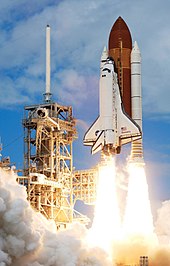
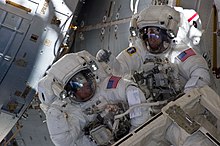
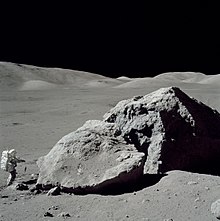
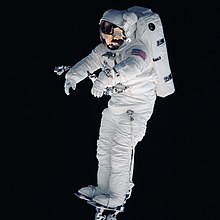
NASA has successfully launched over 200 crewed flights. Three have ended in failure, causing the death of the entire crew: Apollo 1 (which never launched) in 1967 lost three crew members, STS-51-L (the Challenger disaster) in 1986, and STS-107 (the Columbia disaster) in 2003.
| Program | Start date | First crewed flight | End date | No. of crewed missions launched | Notes |
|---|---|---|---|---|---|
| Mercury program | 1958 | 1961 | 1963 | 6 | First U.S. crewed program |
| Gemini program | 1961 | 1965 | 1966 | 10 | Program used to practice space rendezvous and EVAs |
| Apollo program | 1960 | 1968 | 1972 | 11 [a] | Landed first humans on the Moon |
| Skylab | 1964 | 1973 | 1974 | 3 | First American space station |
| Apollo–Soyuz Test Project | 1971 | 1975 | 1975 | 1 | Joint with Soviet Union |
| Space Shuttle program | 1972 | 1981 | 2011 | 135 [b] | First missions in which a spacecraft was reused |
| Shuttle-Mir program | 1993 | 1995 | 1998 | 11 [c] | Russian partnership |
| International Space Station | 1993 | 1998 | Ongoing | 65 | Joint with Roscosmos, CSA, ESA, and JAXA; Americans flew on Russian Soyuz after 2011 retirement of Space Shuttle |
| Commercial Crew Program | 2011 | 2020 | Ongoing | 3 | Current program to shuttle Americans to the ISS |
| Artemis program | 2017 | Ongoing | Ongoing | 0 | Current program to bring humans to the Moon again |
Notes:
In May 2009, the Obama Administration announced the launch of an independent review of planned U.S. human space flight activities with the goal of ensuring that the nation is on a vigorous and sustainable path to achieving its boldest aspirations in space. The review was conducted by a panel of experts led by Norman Augustine, the former CEO of Lockheed Martin, who served on the President's Council of Advisers on Science and Technology under both Democrat and Republican presidents. [5]
The "Review of United States Human Space Flight Plans" was to examine ongoing and planned National Aeronautics and Space Administration (NASA) development activities, as well as potential alternatives and present options for advancing a safe, innovative, affordable, and sustainable human space flight program in the years following Space Shuttle retirement. The panel worked closely with NASA and sought input from the United States Congress, the White House, the public, industry, and international partners as it developed its options. It presented its results on October 22, 2009. [6] [7] [8]
In February 2010, Obama announced his proposal to cancel the Constellation Program as part of the 2011 Economic Projects. Constellation was officially canceled by the NASA Budget Authorization Act on October 11, 2010.
NASA brought the Orion spacecraft back to life from the defunct Constellation Program and successfully test-launched the first capsule on December 5, 2014, aboard EFT-1. After a near-perfect flight traveling 3,600 miles (5,800 km) above Earth, the spacecraft was recovered for study. NASA plans to use the Orion crew vehicle to send humans to deep space locations such as the Moon and Mars starting in the 2020s. Orion will be powered by NASA's new heavy-lift vehicle, the Space Launch System (SLS), which is currently under development.
Artemis 1 is the first flight of the SLS and was launched as a test of the completed Orion and SLS system. [9] During the mission, an uncrewed Orion capsule will spend 10 days in a distant retrograde 60,000 kilometers (37,000 mi) orbit around the Moon before returning to Earth. [10] Artemis 2, the first crewed mission of the program, will launch four astronauts in 2024 [11] on a free-return flyby of the Moon at a distance of 8,900 kilometers (5,500 mi). [12] [13] [14]
After Artemis 2, the Power and Propulsion Element of the Lunar Gateway and three components of an expendable lunar lander are planned to be delivered on multiple launches from commercial launch service providers. [15]
Artemis 3 is planned to launch in 2025 [16] aboard an SLS Block 1 rocket and will use the minimalist Gateway and expendable lander to achieve the first crewed lunar landing of the program. The flight is planned to touch down on the lunar south pole region, with two astronauts staying there for about one week. [15] [17] [18] [19] [20]

The Mariner program was conducted by the American space agency NASA to explore other planets. Between 1962 and late 1973, NASA's Jet Propulsion Laboratory (JPL) designed and built 10 robotic interplanetary probes named Mariner to explore the inner Solar System - visiting the planets Venus, Mars and Mercury for the first time, and returning to Venus and Mars for additional close observations.

The Pioneer programs were two series of United States lunar and planetary space probes exploration. The first program, which ran from 1958 to 1960, unsuccessfully attempted to send spacecraft to orbit the Moon, successfully sent one spacecraft to fly by the Moon, and successfully sent one spacecraft to investigate interplanetary space between the orbits of Earth and Venus. The second program, which ran from 1965 to 1992, sent four spacecraft to measure interplanetary space weather, two to explore Jupiter and Saturn, and two to explore Venus. The two outer planet probes, Pioneer 10 and Pioneer 11, became the first two of five artificial objects to achieve the escape velocity that will allow them to leave the Solar System, and carried a golden plaque each depicting a man and a woman and information about the origin and the creators of the probes, in case any extraterrestrials find them someday.

Space exploration is the use of astronomy and space technology to explore outer space. While the exploration of space is currently carried out mainly by astronomers with telescopes, its physical exploration is conducted both by uncrewed robotic space probes and human spaceflight. Space exploration, like its classical form astronomy, is one of the main sources for space science.

A gravity assist, gravity assist maneuver, swing-by, or generally a gravitational slingshot in orbital mechanics, is a type of spaceflight flyby which makes use of the relative movement and gravity of a planet or other astronomical object to alter the path and speed of a spacecraft, typically to save propellant and reduce expense.

A lander is a spacecraft that descends towards, then comes to rest on the surface of an astronomical body other than Earth. In contrast to an impact probe, which makes a hard landing that damages or destroys the probe upon reaching the surface, a lander makes a soft landing after which the probe remains functional.

The planet Mars has been explored remotely by spacecraft. Probes sent from Earth, beginning in the late 20th century, have yielded a large increase in knowledge about the Martian system, focused primarily on understanding its geology and habitability potential. Engineering interplanetary journeys is complicated and the exploration of Mars has experienced a high failure rate, especially the early attempts. Roughly sixty percent of all spacecraft destined for Mars failed before completing their missions, with some failing before their observations could even begin. Some missions have been met with unexpected success, such as the twin Mars Exploration Rovers, Spirit and Opportunity, which operated for years beyond their specification.

The Discovery Program is a series of Solar System exploration missions funded by the U.S. National Aeronautics and Space Administration (NASA) through its Planetary Missions Program Office. The cost of each mission is capped at a lower level than missions from NASA's New Frontiers or Flagship Programs. As a result, Discovery missions tend to be more focused on a specific scientific goal rather than serving a general purpose.

Mariner Mark II was NASA's planned family of uncrewed spacecraft for the exploration of the outer Solar System that were to be developed and operated by JPL between 1980 through the year 2010.

The following outline is provided as an overview of and topical guide to space exploration.
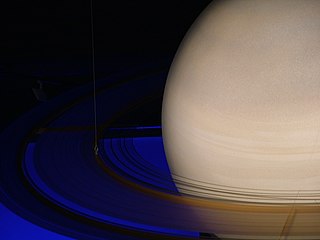
The exploration of Saturn has been solely performed by crewless probes. Three missions were flybys, which formed an extended foundation of knowledge about the system. The Cassini–Huygens spacecraft, launched in 1997, was in orbit from 2004 to 2017.

The advanced Stirling radioisotope generator (ASRG) is a radioisotope power system first developed at NASA's Glenn Research Center. It uses a Stirling power conversion technology to convert radioactive-decay heat into electricity for use on spacecraft. The energy conversion process used by an ASRG is significantly more efficient than previous radioisotope systems, using one quarter of the plutonium-238 to produce the same amount of power.

The National Aeronautics and Space Administration is an independent agency of the U.S. federal government responsible for the civil space program, aeronautics research, and space research. Established in 1958, it succeeded the National Advisory Committee for Aeronautics (NACA) to give the U.S. space development effort a distinctly civilian orientation, emphasizing peaceful applications in space science. It has since led most American space exploration, including Project Mercury, Project Gemini, the 1968–1972 Apollo Moon landing missions, the Skylab space station, and the Space Shuttle. It currently supports the International Space Station and oversees the development of the Orion spacecraft and the Space Launch System for the crewed lunar Artemis program, the Commercial Crew spacecraft, and the planned Lunar Gateway space station.
Robert Samuel Kraemer was an American aerospace engineer who served as Director of Planetary Programs at the National Aeronautics and Space Administration from 1971 to 1976.

The Planetary Missions Program Office is a division of NASA headquartered at the Marshall Space Flight Center, formed by the agency's Science Mission Directorate (SMD). Succeeding the Discovery and New Frontiers Program Office, it was established in 2014 to manage the Discovery and New Frontiers programs of low and medium-cost missions by third-party institutions, and the Solar System Exploration program of NASA-led missions that focus on prioritized planetary science objectives. The Discovery and New Frontiers programs were established in 1992 and 2001 respectively, and have launched fourteen primary missions together, along with two missions launched under the administration of the Planetary Missions Program Office. The Solar System Exploration Program was established alongside the office, with three missions planned for launch under the new program.
And before NASA sends astronauts to the moon in 2024, the agency will first have to launch five aspects of the lunar Gateway, all of which will be commercial vehicles that launch separately and join each other in lunar orbit. First, a power and propulsion element will launch in 2022. Then, the crew module will launch (without a crew) in 2023. In 2024, during the months leading up to the crewed landing, NASA will launch the last critical components: a transfer vehicle that will ferry landers from the Gateway to a lower lunar orbit, a descent module that will bring the astronauts to the lunar surface, and an ascent module that will bring them back up to the transfer vehicle, which will then return them to the Gateway.
Under the NASA plan, a mission to land on the moon would take place during the third launch of the Space Launch System. Astronauts, including the first woman to walk on the moon, Mr. Bridenstine said, would first stop at the orbiting lunar outpost. They would then take a lander to the surface near its south pole, where frozen water exists within the craters.